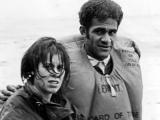American Lynne Cox swam from the North Island to the South in 12 hours 7 minutes. The fourth person to do so, she battled heavy seas and strong winds.
Cook Strait
Events In History
The liner, carrying 400 passengers, struck Barrett Reef in Wellington Harbour on 19 January. Only an unusually long spell of calm weather - dubbed 'Wanganella weather' by locals - saved it from becoming a total wreck.
Captain Euan Dickson completed the first air crossing of Cook Strait, flying a 110-hp Le Rhone Avro from Christchurch to Upper Hutt with the first air mail between the South and North Islands.
The Picton-Wellington ferry SS Penguin struck rocks in Cook Strait and sank in heavy seas off a rugged, isolated coast. Only 30 of the 102 people on board survived.
After two bungled attempts and near disaster at sea, the installation of the first communications cable between the North and South Islands of New Zealand was completed. A simple copper telegraph cable was laid on the sea floor from Whites Bay, north of Blenheim, to Lyall Bay on Wellington’s south coast.
Articles
Wahine disaster

This April marks the 45th anniversary of the sinking of the ferry Wahine. With more than 50 lives lost, this was New Zealand's worst modern maritime disaster. The Wahine’s demise on 10 April 1968 also heralded a new era in local television, as pictures of the disaster were beamed into living rooms around the country. Read the full article
Page 2 - Timeline to tragedy
The events that led to the drowning of 51 people in the Wahine disaster of 10 April
Cook Strait rail ferries

On a fine, calm day ‘Cruising on the Interislander’ can be like a luxury Mediterranean cruise. But on a bad day Cook Strait can be one of the world's roughest stretches of water: seasickness, dodgy food and wildcat strikes have all been part of the colourful Cook Strait ferry story. Read the full article
Page 1 - Cook Strait rail ferries
On a fine, calm day ‘Cruising on the Interislander’ can be like a luxury Mediterranean cruise. But on a bad day Cook Strait can be one of the world's roughest stretches of water:
Page 2 - 'The floating bridge'
Before 1962 rail struggled to compete with ships for inter-island business, but the road/rail ferries changed that.
Page 3 - 'An array of awful pies'
In the 1960s, the ferries' food and services fell short of the glossy ads, but now they are more
Page 4 - Rough crossings
Crossing Cook Strait is often idyllic, but it can be one of the world’s roughest stretches of water as it's part of the westerly wind belt known as the Roaring
Page 5 - Branding the Cook Strait ferries
From 'puke' green to funnells sprouting ferns, the ferries' branding and appearance have had many changes.
Page 6 - Strikes and strandings
Cook Strait ferries were vital to the flow of freight and passengers between the North and South islands, and interruptions because of bad weather, mechanical problems or
Page 7 - Fast ferries on Cook Strait
The old fable about the tortoise and the hare was replayed on Cook Strait as fast ferries offered travellers a quick dash across the
Page 8 - Sailing into the 21st century
The new century brought mixed fortunes for Cook Strait’s ‘iron




























